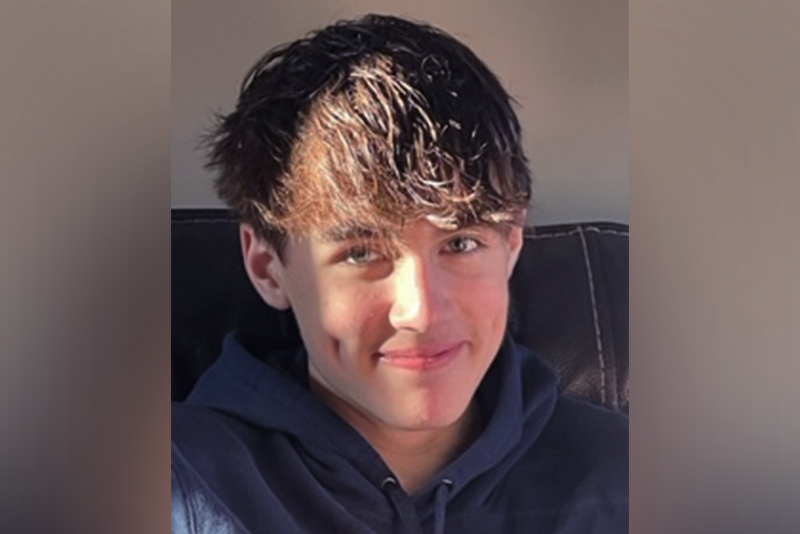‘Worth the trip’: Aiden and his family found help for chronic pain in Boston

Aiden Kozak loves playing volleyball — and he’s good at it. He was even recently named one of the top 50 student volleyball players on Long Island. It’s a huge change from four years ago, when walking was so painful that he relied on a wheelchair.
That wasn’t always the case. Until he was 12, Aiden was an active kid who enjoyed playing baseball. Then, one morning in 2017, his world changed. “When he woke up, he couldn’t put any weight on his foot, and his leg was swollen and discolored,” remembers his mother, Christine. That began a long search for answers — and an even longer journey to find the right care.
“Aiden,” says Christine, “was a boy whose life was temporarily turned upside down.”
Doing whatever it took
After a series of tests — and prompting by his pediatrician not to stop until he received an accurate diagnosis — Aiden learned he had complex regional pain syndrome (CRPS). This condition can cause persistent pain, sensitivity to touch, swelling, and changes in skin color in the affected limb. It appears to be the result the nervous system’s abnormal response to an injury — even a seemingly minor one — although in Aiden it didn’t appear to have an obvious cause. “It felt really surreal, like this couldn’t be happening to us,” says Christine.
When Aiden’s physician recommended three hospitals for intensive rehabilitation, his parents chose the location closest to them. But when he didn’t improve after four weeks at a program in New Jersey, they knew he needed more specialized care and reached out to Boston Children’s Pediatric Pain Rehabilitation Center (PPRC). Although they knew that juggling Aiden’s care in Boston with their two younger children in New York would be challenging, they also knew it would be worth the trip out of state. “We would do whatever it took,” says his mom.

Resistance — then progress
The experience was challenging at first. Aiden felt anxious about the situation and initially the intensive day program was overwhelming. The program can involve working with physical and occupational therapists, psychologists, doctors, nurses, and other experts to help manage chronic pain. Although he did have bad days in the beginning, he started to make progress, which motivated him to continue.
Part of Aiden’s progress stemmed from the fact that the PPRC team worked with him to learn what activities he enjoyed and then design a plan around them. “They truly got to know Aiden and connect with him,” says Christine, who also found the group meetings with other parents helpful. “It was so comforting to be around other parents who knew what we were going through — it was a huge support system,” she explains. “We made immediate and lasting connections.”

A life-changing experience
After 15 weeks at the PPRC, Aiden and his family had gained a new sense of understanding and control over his chronic pain. He’s developed coping strategies to help manage it, thanks to the PPRC’s clinical director, Dr. Navil Sethna, and his team, including psychologist Dr. Caitlin Conroy and physical therapist Julie Shulman. And his parents have found ways to better support him. “We learned that you have to step back as a parent and let the experts guide you,” says Christine. “In some ways, that goes against parental instincts, but in the long run it helps your child.”
Now 16, Aiden is a “typical” teenager who runs track in addition to playing volleyball. He still keeps in touch with friends he made at the PPRC and hopes to pursue a career in orthopedics — a dream strongly influenced by his experience. “His time at the PPRC has had so many positive effects,” says his mom. “It changed all of our lives.”
Learn more about the Pediatric Pain Rehabilitation Center.
Related Posts :
-

No longer just 'getting through the day': Addressing Lucie's chronic pain
Lucie Robert had always been an engaged and active kid: At just 10 years old, she loved Nordic skiing, dancing, and ...
-

Chronic headaches in kids: How a psychologist can help your child cope
For many young people, the pain of chronic daily headaches can be compounded by the concern that providers aren’t ...
-

Interventional techniques help Molly thrive with chronic pain
Molly McGowan loves baking, sewing, and taking daily walks in the woods with her goldendoodle, Cooper. But Cooper isn’t ...
-

Minimally invasive approaches help ease Sydney's chronic pain
Sydney Hart wants to reimagine the traditional “handicap” symbol. In her online shop, she offers pins, stickers, and other products ...





